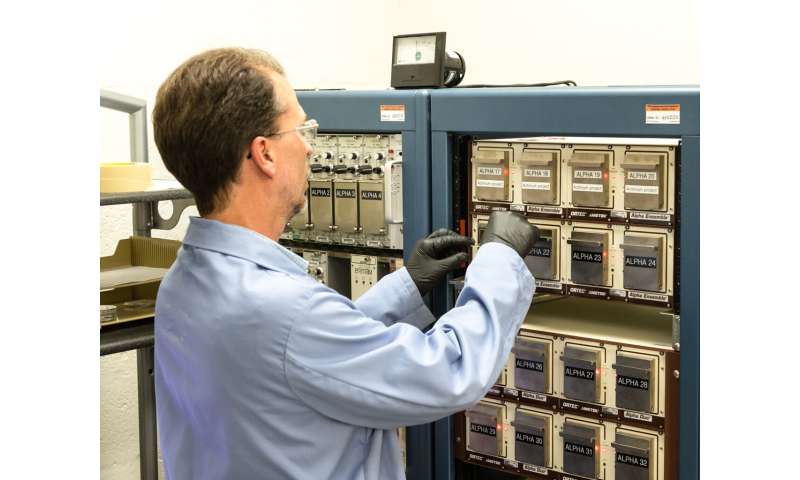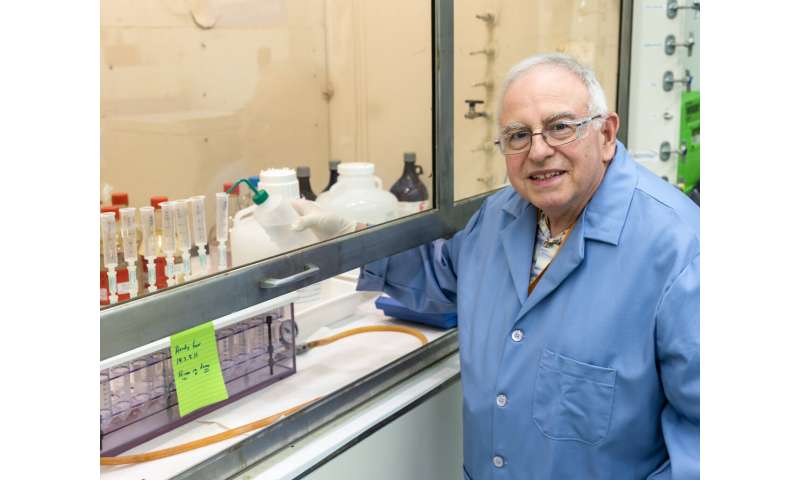At ORNL, 18 nuclear analytical chemistry methods get international stamp of approval

The International Standards Organization has put its stamp of approval on 18 nuclear analytical chemistry methods at the Department of Energy's Oak Ridge National Laboratory. These testing and calibration methods have received ISO 17025 accreditation.
"Accreditation serves DOE missions in environmental stewardship, isotope production and nuclear security," said Joe Giaquinto, head of ORNL's Nuclear Analytical Chemistry section. "It gives the public, our regulators, our sponsors—everybody we supply these measurements with—confidence that the data that we produce meet the highest quality standards."
The Chemical and Isotopic Mass Spectrometry, or CIMS, group received accreditation for three chemistry methods. Cole Hexel leads the CIMS group, which includes Kayron Rogers, Carson Evans and Shalina Metzger, who were all involved in the accreditation process.
The Radioactive Materials Analytical Lab, or RMAL, received accreditation for 15 environmental tests. Wade Ivey leads the RMAL group, which includes Haley Wightman, Tammy Keever, Adam Martin, Marc Chattin, Bruce Tomkins and Jennifer Botting. All were heavily involved in the audit for accreditation.
"This accreditation is a testament to the accuracy, reproducibility and defensibility of the data generated by these two labs," said radiochemist Jenn Parikh, quality assurance coordinator for ORNL's Nuclear Analytical Chemistry section. "It says we are excellent at what we do."
To uphold the highest standards, the ORNL scientists document and maintain the quality assurance program according to ISO 17025 standards. The standards apply to lab management systems, staff training, measurement traceability, standards maintenance and document handling for the 18 accredited methods. CIMS and RMAL group members also perform several other highly technical methods that conform to the high standards of ISO 17025 and are currently in preparation for accreditation.
CIMS researchers measure bulk analytical sample swipes collected from nuclear facilities worldwide. International inspectors collect these samples under agreements with the International Atomic Energy Agency, or IAEA. The ISO 17025 methods support analytical activities performed for the IAEA by the U.S. State Department Network of Analytical Laboratories. Using the newly accredited methods, the CIMS team also makes baseline measurements that support the National Nuclear Material Archive, sponsored by the DOE National Nuclear Security Administration, or NNSA, Office of Nuclear Forensics.
The accredited methods are especially valuable for organizations—such as NNSA's New Brunswick Laboratory Program Office, or NBLPO—that produce nuclear reference materials. Analytical scientists use reference materials containing certified attributes such as elemental and isotopic amounts as calibration and quality-control standards.
Reference materials are essential for tracing and documenting methods that measure nuclear material for control and accountability. For example, ORNL leads a project with the NBLPO to produce a neptunium reference material. Analysts will use this reference material for accountability measurements to track the neptunium used to make plutonium-238 fuel for NASA's deep space missions.
Similarly, RMAL researchers use ISO 17025-accredited methods to make measurements that support ORNL's science and technology initiatives and strategic partnerships. They focus on environmental detection of radioisotopes and other regulated substances. The group performs analyses for the Environmental Protection Agency and the State of Tennessee Department of Environment and Conservation.
It also performs analyses for compliance monitoring by National Emissions Standard for Hazardous Air Pollutants and National Pollutant Discharge Elimination System programs. RMAL scientists also support required periodic ORNL site monitoring for air and water pollutants.
"It is all part of ORNL being a good steward," Giaquinto said. "The measurements that Wade's group provides give the public confidence that ORNL is controlling its waste and not releasing it into the environment and the community."
The RMAL researchers also use ISO 17025-accredited techniques to support ORNL's production of stable and radioactive isotopes. They analyze medical isotopes produced on-site for ORNL's Isotope Science and Engineering Directorate.

The accredited methods also aid analysis of an accident-tolerant nuclear fuel. Researchers in ORNL's Fission and Fusion Energy and Science Directorate study the potential of tri-structural isotropic particle fuel, or TRISO, for advanced nuclear reactors.
Attaining ISO 17025 accreditation requires a stringent process. "There's a big difference between accreditation and certification," Ivey said. "Millions of companies are ISO 9001-certified. The accreditation for ISO 17025 looks deeper. Is your method technically sound and properly documented? Is your staff capable of following it?"
For three years, Rogers, an analytical chemist in ORNL's CIMS group, was involved in accreditation activities involving the Davies and Gray titration method for assaying uranium. "A big step was participating in proficiency testing," she said. "That's where an independent outside source will send blind samples to the lab. We analyze those samples and report our results back and get graded on our proficiency to perform the method."
The IAEA, among others, provides the proficiency test. That agency is interested in the content of specific isotopes of uranium and the uranium concentration of samples.
"Isotopic analysis is an important aspect of safeguarding material and monitoring facilities worldwide to account for material," said Cole Hexel, whose CIMS group received ISO 17025 accreditation for isotopic and material assay testing.
"In this last proficiency test, 29 labs worldwide participated. The IAEA will compare the value that they got in their own lab with our result," explained Rogers. "Then you're judged on your result. And now, having ISO 17025-accredited methods, it is part of our duty to participate in future proficiency tests that provide a measure of our precision and accuracy."
Rogers added, "Accreditation definitely helps us toward our goal of becoming the premier research institution in nuclear analytical chemistry."
Giaquinto agreed: "Our years of providing high-quality analytical data and having that ISO 17025 accreditation present new, bigger and better opportunities."
"Our plan moving forward is to add additional methods each year," said Parikh, who called the hard work to get techniques accredited "a labor of love."
"Accreditation is the hard part, but it's not over," Ivey said. Periodic audits will ensue, along with participation in proficiency tests. However, ORNL will now be on the receiving end, testing methods from other labs or contributing to consensus answers—under ever-watchful eyes. "We have to get within a certain known value of what the answer is, or they could remove our accreditation of that technique. So we're continuously being tested and audited to keep it."
Provided by Oak Ridge National Laboratory